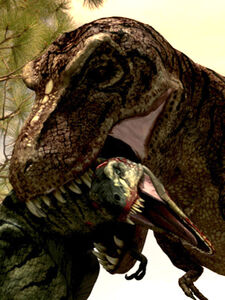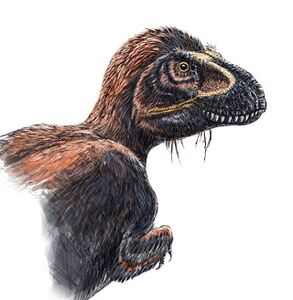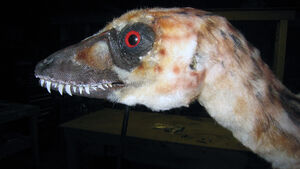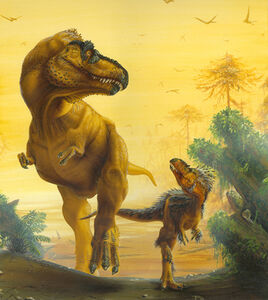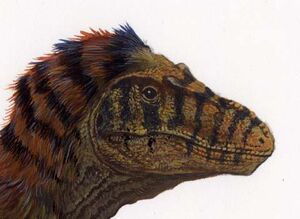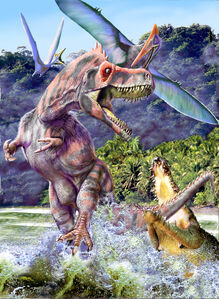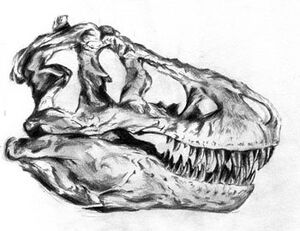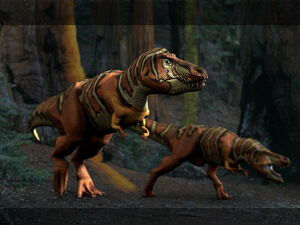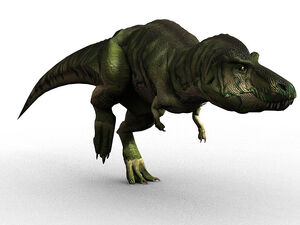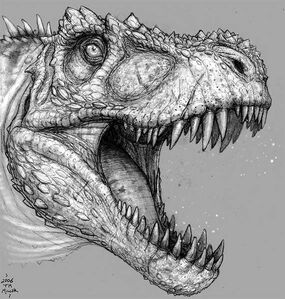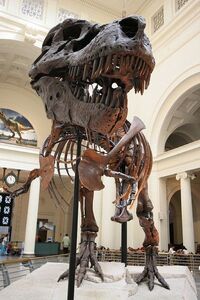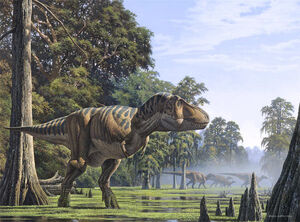
Here is Tyrannosaurus in its environment.
Tyrannosaurus rex is a species of tyrannosaurid dinosaur from 68.5-65.5 million years ago (ma/mya) of the Late Cretaceous. It was native to North America and Asia. Tyrannosaurus is the largest carnivorous dinosaur to roam Western North America and Asia. Tyrannosaurus is defined by small arms only 3 feet (1 m) in length (some such as in T. bataar were even smaller because of dwarfism) and giant jaws (mandibles) with gargantuan teeth. Tyrannosaurus is one of the most famous of the dinosaurs because when it was described in 1905 it was the largest known theropod discovered. Not until the late 1990's and early 2000's Tyrannosaurus rex reigned as the largest carnivorous dinosaur,ranging from 40-to43 ft(12.3-13.2m) 20-21.5 ft(6.15-6.6 m) tall and up to 9.8 tons in weight.
Classification and History of Discoveries[]
Taxonomy[]
Superorder: Dinosauria
Order: Saurischia
Suborder: Theropoda
Unranked: Coelurosauria/Tyrannoraptora
Superfamily: Tyrannosauroidea
Family: Tyrannosauridae
Subfamily: Tyrannosaurinae
Tribe: Tyrannosaurini
Genus: Tyrannosaurus
Species: Tyrannosaurus rex
Tyrannosaurus rex fits into the superorder Dinosauria obviously, skipping down, T. rex fits in the unranked suborder Coelurosauria, the superfamily Tyrannosauroidea, the family Tyrannosauridae, the subfamily Tyrannosaurinae, the tribe Tyrannosaurini and the genus Tyrannosaurus.
More specific information: Go to The Phylogenetic Position of the Tyrannosauridae
History of Discoveries[]
All animals back in the mid Twentieth Century that were theropod heavy-weights were bulky, tail-dragging, stupid brutes. They were all ectothermic (cold-blooded). Not until the 1960s through 1980s was this corrected when Deinonychus was discovered by John Ostrom. [1] This period of dinosaur knowledge was started by Robert Bakker, John Ostrom and many other paleontologists. This find suggested that dinosaurs were agile, smart and endothermic (warm-blooded). Due to all of the change in our dinosaur mind they called it the "Dinosaur renaissance". [2] From the 1970s on, large theropods, such as T. rex, had their tails strait out behind them in the air and were thin, not bulky as they were before. But who knows, maybe one day all we knew about T. rex could be wrong.
